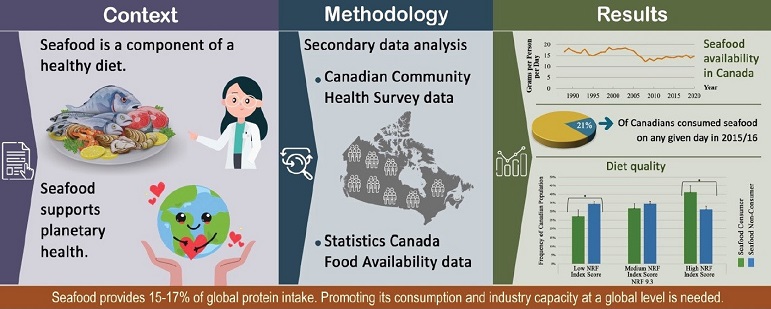DO SEAFOOD CONSUMERS HAVE A HIGHER DIET QUALITY COMPARED TO NON-CONSUMERS? A CANADIAN PERSPECTIVE
DOI:
https://doi.org/10.46754/ps.2023.07.004Keywords:
Fish, shellfish, planetary health, nutrient density, nutrient-rich food index, national survey data, Canadian Community Health SurveyAbstract
Seafood represents a nutritious source of protein for many Canadians, including substantial amounts of omega-3 polyunsaturated fatty acids, vitamin D, vitamin B12, vitamin B6, and niacin. Many national and international dietary guidelines recommend regular consumption of seafood to support a healthy diet. The consumption of seafood continues to gain public attention due to its role in a healthy diet and its influence on environmental sustainability.
References
Abdulla, M., Martin, R. C., Gooch, M., & Jovel, E. (2013). The importance of quantifying food waste in Canada. Journal of Agriculture, Food Systems, and Community Development, 3(2), 137-151.
Auclair, O., & Burgos, S. A. (2020). Protein consumption in Canadian habitual diets: Usual intake, inadequacy, and the contribution of animal- and plant-based foods to nutrient intakes. Applied Physiology, Nutrition, and Metabolism, 46(5), 501-510.
Boyd, C. E., McNevin, A. A., & Davis, R. P. (2022). The contribution of fisheries and aquaculture to the global protein supply. Food Security, 14, 805-827.
Drewnowski, A. (2010). The nutrient rich foods index helps to identify health, affordable foods. American Journal of Clinical Nutrition, 91(4), 1095S-1101S.
EAT-Lancet Commission. (2019). The EATLancet commission summary report. Accessed on October 14th, 2022, from https:// eatforum.org/eat-lancet-commission/eatlancet-commission-summary-report/
Fisheries and Oceans Canada. (2018). Outlook to 2027 for Canadian Fish and Seafood. Accessed on October 14th, 2022, from https://waves-vagues.dfo-mpo. gc.ca/Library/40732836.pdf
Food and Agriculture Association of the United Nations [FAO of UN]. (2021). Fishery and aquaculture statistics. Accessed on October 14th, 2022, from https://www.fao.org/fishery/ en/statistics
Food and Agriculture Organization of the United States [FAO of US]. (2022). Food-based dietary guidelines. Accessed on October 14th, 2022, from https://www.fao.org/ nutrition/education/food-dietary-guidelines/ home/en/
Gabriel, A. S., Ninomiya, K., & Uneyama, H. (2018). The role of Japanese traditional diet in health and sustainable dietary patterns around the world. Nutrients, 10, 173- 188.
Ganter, S., Crawford, T., Irwin, C., Robichaud, V., & DeMaio-Sukic, A. (2021). Canada’s oceans and the economic contribution of marine sectors. Statistics Canada, EnviroStats.
Guillen, J., Natale, F., Carvalho, N., Casey, J., Hofherrm J., Druon, J. N., Fiore, G., … Martinsohn, J. T. (2019). Global seafood consumption footprint. Ambio, 48, 111-122.
Health Canada. (2007). Eating well with Canada’s food guide. Accessed on October 14th, 2022, from https://publications.gc.ca/ collections/Collection/H164-38-1-2007E. pdf
Health Canada. (2010). Nutrient value of some common foods. Accessed on October 14th, 2022, from https://www.canada.ca/ en/health-canada/services/food-nutrition/ healthy-eating/nutrient-data/table-8-fishshellfish-nutrient-value-some-commonfoods-2008.html
Health Canada. (2019). Canada’s food guide. Accessed on October 14th, 2022, from https://food-guide.canada.ca/en/
Hu, X. F., & Chan, H. M. (2021). Seafood consumption and its contribution to nutrients intake among Canadians in 2004 and 2015. Nutrients, 13(1), 77-88.
Jayedi, A., & Shab-Bidar, S. (2020). Fish consumption and the risk of chronic disease: An umbrella review of metaanalyses of prospective cohort studies. Advances in Nutrition, 11(5), 1123-1133.
Kawarazuka, N., & Bene, C. (2011). The potential role of small fish species in improving micronutrient deficiencies in developing countries: Building evidence. Public Health Nutrition, 14(11), 1927-38.
Larsen, R., Eilersten, E. K., & Elvevoll, E. O. (2011). Health benefits of marine foods and ingredients. Biotechnol. Advances, 29(5), 508-18.
Lovegrove, C., Ahmed, K., Challacombe, B., Khan, M. S., Popert, R., & Dasgupta, P. (2015). Systematic review of prostate cancer risk and association with consumption of fish and fish‐oils: Analysis of 495,321 participants. International Journal of Clinical Practice, 69(1), 87-105.
Naylor, R. L., Kishore, A., Sumaila, U. R., Issifu, I., Hunter, B. P., Belton, B., Bush, S. R., … Crona, B. (2021). Blue food demand across geographic and temporal scales. Nature Communications, 5413(12).
Naylor, R. L., Hardy, R. W., Bushman, A. H., Bush, S. R., Cao, L., Kliner, D. H., Little, D. C., … Troell, M. (2021). A 20-year retrospective review of global aquaculture. Nature, 591, 551-563.
Ruzton, C. H. (2011). The benefits of fish consumption. Nutrition Bulletin, 36(1), 6-19.
Sanou, D., O’Rilley, E., Ngnie-Teta, I., Batal, M., Mondain, N., Andrew, C., Newbold, B., & Bourgeault, I. L. (2014). Acculturation and nutritional health of immigrants in Canada: A scoping review. Journal of Immigrant and Minority Health, 16, 24-34.
Statista Research Department. (2022). Distribution of new immigrants arriving in Canada in 2021, by country of origin. Accessed on October 14th, 2022, from https:// www.statista.com/statistics/1171597/newimmigrants-canada-country/ Statistics
Canada. (2019). Canadian Community Health Survey (CCHS) - 2019. Accessed on October 14th, 2022, from https://www23. statcan.gc.ca/imdb/p3Instr.pl?Function=ass embleInstr&lang=en&Item_Id=1207185
Statistics Canada. (2021). Detailed food spending, Canada, regions and provinces. Accessed on October 12th, 2022, from https://doi.org/10.25318/1110012501-eng
Statistics Canada. (2022). Food Availability (per person). Accessed on October 14th, 2022, from https://www23.statcan.gc.ca/ imdb/p2SV.pl?Function=getSurvey&SD DS=3475
Toell, M., Jonell, M., & Crona, B. (2019). Scoping report: The role of seafood in sustainable healthy diets. Accessed on March 15th, 2023, from https://eatforum. org/content/uploads/2019/11/Seafood_ Scoping_Report_EAT-Lancet.pdf U.S.
Department of Health and Human Services [HHS]. (2021). 2015–2020 Dietary Guidelines. Accessed on October 14th, 2022, from https://health.gov/our- w o r k / food-and-nutrition/2015-2020-dietaryguidelines/
Yuan, J. M., Ross, R. R., Gao, Y. T., & Yu, M. C. (2001). Fish and shellfish consumption in relation to death from myocardial infarction among men in Shanghai, China. American Journal of Epidemiology, 154(9), 809-16.
Zalloua, P. A., Hsu, Y., Terwedow, H., Zang, T., Wu, D., Tang, G., Li, Z.,… Xu, X. (2007). Impact of seafood and fruit consumption on bone mineral density. Maturitas, 56(1), 1-11.

Downloads
Published
How to Cite
Issue
Section
License
Copyright (c) 2024 Planetary Sustainability

This work is licensed under a Creative Commons Attribution-ShareAlike 4.0 International License.




